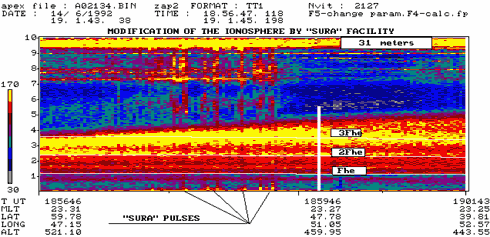|

1) Stimulated HF emission in topside ionosphere during ionosphere modification experiment by
heating facility "Sura" near Nizhny Novgorod, Russia, was detected by Coronas-I satellite.
Pump frequency in these experiments was slightly less then critical frequency foF2 of F2-layer.
Ionosphere heating was performed at dusk time when pump wave reflection level was located rather
high. These conditions was optimal for penetration in topside ionosphere of electrons
accelerated within turbulent region near reflection level. Stimulated emission with frequencies
near 3-rd and 5-th electron gyroharmonic was registered by Coronas-I satellite.
2) It is shown that at conditions when pump frequency is less then f0F2 stimulated
emission of Bernstein modes in topside ionosphere can be generated by accelerated electrons
with anisotropic distribution.
3) The ionosphere plasma interaction with a beam and the generation of plasma waves was
investigated In active experiments with the injection of electron and plasma beams on board of
the APEX satellite. Wave and particle measurements carried out in a near zone have allowed to
note a number of plasma excitation pecularities near to a space vehicle, and also its charge
neutralization The strong disturbance of space plasma surrounding the spacecraft is caused by
a small density of background plasma. The features connected to the generation of plasma waves
and the distribution of particles, in conditions of a number realization of active influences
on the upper ionosphere are considered. Under the operation mode of the single electron gun
were excited mainly upper hybrid and whistler waves, but the switch on of a plasma gun resulted
in the generation of emissions in a vicinity of electron gyroharmonics. Immediately after the
swich on of an electron gun the probes detected the occurrence of short-term bursts of
accelerated (hundreds eV) ions at some pitch-angles. The electron energy distribution had a
complex dynamic structure with two maxima at ~100 eV and ~3-5 keV. This structure depends
on an disposition of probes and caused by flows of returned and injected electrons.
|






